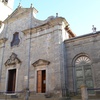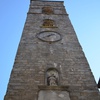Parish Church of Fosciana
Definitely worth a visit is the parish church of San Giovanni Battista, one of the oldest in the Garfagnana, which was built in the Romanesque style. The apse, decorated with arches and pilasters, preserves traces of the original building; the facade and the bell tower are part of the renovation from the XVIII century. Inside there are valuable works of art, including two statues in glazed terracotta by Andrea della Robbia (1435-1525) and some paintings by Antonio Consetti.
The village is built not far from the church and was subject to the direct control of the Gherardinghi nobles. The centre became quite important, so much so that it hosted Countess Matilde of Canossa in 1105 from where she promulgated certain deeds.
Historical notes
The existence of this place of worship is evidenced by a document of 764 which mentions the church "de Bassirica" dedicated to Saints Ippolito and Cassiano. This was one of the most important churches in the diocese of Lucca and, administering a vast territory, it appeared in a large number of documents related to different locations, such as for example "Fosciano","Campulo" and "Barginne".
Between the end of the twelfth and thirteenth centuries, the centre had been affected by the wars conducted by the city of Lucca in order to conquest the area. After various events which first put the village under the authority of Castruccio Castracani of Pisa, in 1369 it returned to become onw of the possessions of Lucca. Later the village was in the middle of the disputes between Lucca, Pisa and Florence until, under the Guinigiano government, the expansionist aims of the enemies of Lucca were not placated.
When Paolo Guinigi fell (1430), the community of Pieve Fosciana, like others in the area, decided to become part of the domains of the Marquis Niccolò d'Este. From then on the town experienced a long period of peace, except for the two wars that opposed the Republic of Lucca with the Este.










